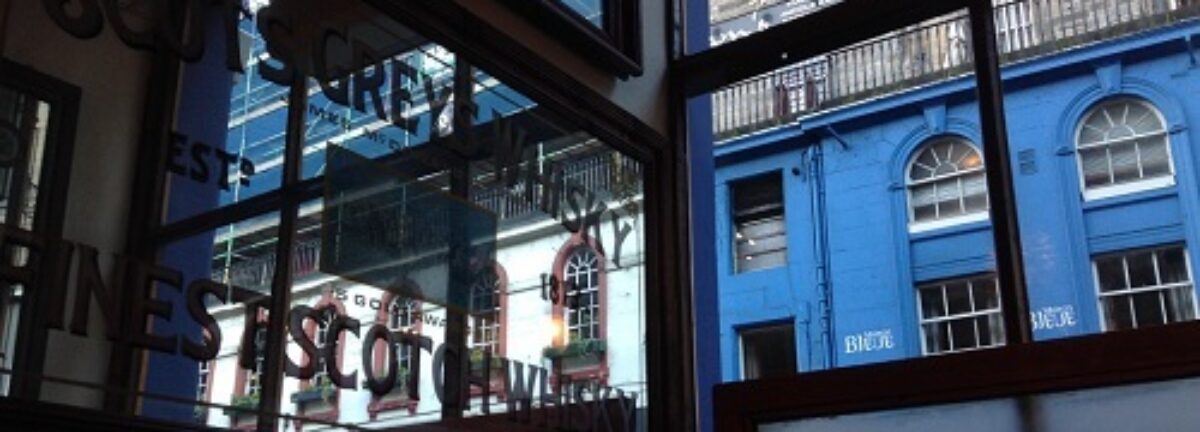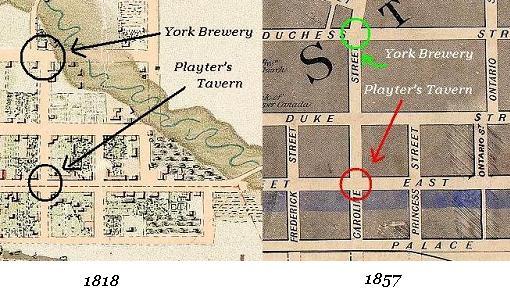Last time I saw one of these was back in 2005. It may have a ways to go before it is done but we do have a fire boat now.
Category: Ontario
Ontario: The Red Lion Inn, Yonge Street, Toronto
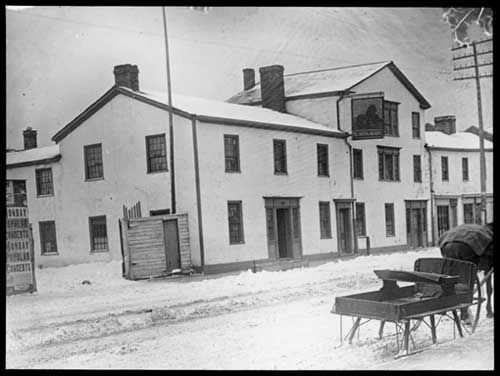 Came across this image of the Red Lion Inn in Toronto at the Archives of Ontario. The photo is from 1886 and shows a building well into its eighth decade according to this blog post of just a few months ago. Built in what was then the country, it was the first stage coach destination on the western route out of the capital, then named York, located around what is now Yonge and Bloor. It would have been about 2 miles to the NNW of the slightly older Playter’s Tavern.
Came across this image of the Red Lion Inn in Toronto at the Archives of Ontario. The photo is from 1886 and shows a building well into its eighth decade according to this blog post of just a few months ago. Built in what was then the country, it was the first stage coach destination on the western route out of the capital, then named York, located around what is now Yonge and Bloor. It would have been about 2 miles to the NNW of the slightly older Playter’s Tavern.
What I like about the photo is how it likely displays three or four additions to what Roberts describes as the original Upper Canadian government approved standard layout Georgian wooden frame structure with the front door centered between two main floor windows and beneath the center window on the second floor. There would have been a chimney at each end of the building, though in the photo the one farther from the photographer could have been rebuilt when the next taller extension was built. The announcement of its opening was set out in a notice in the Gazette of June 13, 1808:
Beefsteak and Beer House. — The subscriber informs his friends and the public that he has opened a house of entertainment next door to Mr. Hunt’s, where his friends will be served with victualing in good order, on the shortest notice, and at a cheap rate. He will furnish the best strong beer at 8d. New York currency per gallon if drank in his house, and 2 s. 6d. New York currency taken out. As he intends to keep a constant supply of racked beer, with a view not to injure the health of his customers, and for which he will have to pay cash, the very small profits at which he offers to sell, will put it out of his power to give credit, and he hopes none will be asked. N.B. He will immediately have entertainment for man and horse. Daniel Tiers. York, 12th January, 1808.
Not sure what entertainment for the horse suggested. I expect the original tavern would have looked a lot like the brick-built Fryfogel’s Tavern near New Hamburg in Perth County, under 100 miles but a couple of decades of settlement to the west. Like Fryfogel’s, the Red Lion had a ballroom and also served government administrative purposes as a district polling location in elections.
Friday Bullets For The Week Of The Blackout
The power went out. From 3 pm to midnight yesterday. Sat around in one room for the evening and marveled at the power of the battery. I tweeted and listened to radio. Ice was to blame. Ice from the sky. Fortunately, it appears to have rained all night washing away the coating. A few trees in the neighbourhood fell. Now, there is good reason to have those ribs in the freezer:
♦ I like beer as much as the next guy. Probably more. But I am not sure why one of Ontario’s less interesting brewers deserved $1,000,000 in tax support annually.
♦ Really? I assume the PM does not know every implication of every Federal legal brief. And besides. If the brief was correct in relation to same sex marriage, it also means that the same is true for different sex marriage – if you don’t meet a foreign level of consanguinity in your home country, a Canadian marriage would not be valid. No one believes that.
♦ Let’s be clear, then. I am the guy who backed Harper this week, not the National Post. No Senate reform, please. No need to entirely lock up Federal governance, Steve.
♦ Scots apparently are not free to make up their minds. Time to revive the Declaration of Arbroath. “It is in truth not for glory, nor riches, nor honours that we are fighting, but for freedom – for that alone, which no honest man gives up but with life itself.” Makes you weepy just thinking about it.
There. Done. Gotta work one more day before the gorging of rib fest begins. Thanks, blackout, for reminding me to make time for ribs.
More Linky Weekend Goodness For Late Fall
Where were we? Ah, yes. The great explosion of 1840:
Another huge fire erupted on 18 April 1840, this time on Counter’s wharf and, aided by the explosion of gunpowder stored in one of the warehouses, spread across much of the waterfront area. Strong winds helped it extend to the whole of the north block of the Market Square, and to most of the next block up to Store Street (now Princess Street)
Never heard of it until a month or so ago. You would think that the destruction of much of the town would be a folk tale, collective memory. Never understood why Ontario is not interested in its own past like other parts of Canada, the English speaking world.
♦ Saturday night update: The Flea, mon cher, teaches how to KooDon’t.
♦ Best thing ever on the internet: what is brown and sticky?
♦ I had no idea that, besides interest on debt, Italy was actually in the black. Canadian Conservatives everywhere must be hailing it as solvency as they do with Mulroney’s terms.
♦ Really? Do you think? Do you think a cabinet member gets attention from “foreign lady reporters” from nations run by totalitarian regimes because they find Tories hot?
♦ I had no idea that Harper has expanded the Federal public service by 13%. No wonder they think that Mulroney got us to solvency.
♦ What is it with all these odd Tory stories? I mean if they are going to be doing all the social engineering I really hope they know how to plug in the toaster first.
♦ Finally – a break from Ottawa’s amateur hour. A great story from Humblebub.
That’s enough of that. Check out the great series at NCPR on the state of the nations on the two sides of the Great Lakes.
Toronto’s York Brewery And Playter’s Tavern 1801-05
I have been playing around with some passages on Toronto in the first years of the 19th century. Here is what I started with:
⇒ “A recent Fact will corroborate what I have said; A Brewer from Kingston removed to York lately and, on application to the Governor, obtained one of the King’s vessels to transport wheat and other Grain from Kingston and the Bay of Quintie, before beer coud be made – and almost all the Pork, Beer, Butter, Flour, Hams, Mutton, which are used at York are brought by water, from Kingston, Niagara, the Genesee Counttry, &c &c. – In short the Town is supported by the money which the Gentlemen who have Salaries from Government expend in Buildings & other Improvements; and that source begins to fail.“: Letter, Rev John Stuart to the Bishop of Nova Scotia, Kingston, September 14, 1801.
⇒ “Even in 1815, after the establishment of two neighbourhood breweries, Commissariat General Robinson was obliged to buy 8,347 gallons of beer and liquors from Kingston for the men at the cost of L8,800“: Bowering, page 9.
⇒ “York Brewery, southeast corner of Duchess and Sherbourne (Caroline) Streets, 1800-1805. Just when the first commercial brewery in York, and who the brewmaster was may never be known… This brewery may have been operated by Robert Henderson in a notice of sale dated 1809, Henderson advertised a milling plant, brewhouse, working tubs, coolers, two kilns for drying malt, two good wells or water, a stable,” two stills, a townhouse, slaughterhouse and three acres of land“: Bowering, page 91.
⇒ “1805 – Upper Canada – Robert Henderson establishes York’s (Toronto’s) first brewery. It closed 12 years later and the facility was leased by different brewers until 1853“: Sneath, page 329.
So you see there is some question as to when a brewery was first built in Toronto – or what was then York… but then I also remembered In Mixed Company by Roberts and how there was a chapter about an early tavern keeper who kept a diary. Turns out it was written in 1802-02 and turns out she gives the address for the tavern – the corner of King and Caroline Streets. Which made me look up above again and see that Bowering gave an address as well.
 Over time Duchess is now Richmond and Caroline did become Sherbourne but that is enough to dip into the City of Toronto’s historical maps and atlases online collection and – voila. We have the information above. Which also means we can figure out where these spots are today which you will see if you click on that little thumbnail.
Over time Duchess is now Richmond and Caroline did become Sherbourne but that is enough to dip into the City of Toronto’s historical maps and atlases online collection and – voila. We have the information above. Which also means we can figure out where these spots are today which you will see if you click on that little thumbnail.
Roberts explains that the Toronto of Playter’s diary and the founding of its first brewery had 75 to 100 homes and about 320 inhabitants in town, about 420 in the surrounding country as well as about 240 in the military garrison to the west. Both establishments sit in what is even then called Old Town. It’s the administrative capital of the new colony of Upper Canada. Roberts also indicates that drinking in Playter’s included rum, “sling” and punch as well as whiskey, brandy and wine. No beer is mentioned that I see.
I would love to have a read of the diary but, if we think of that letter from Rev. Stuart above, we might quess that early York is something of a Brasilia, a constructed government town. The kind of place that you had wine over beer. Not Stuart’s sort of place. No, he was a beer man. One of the founders of my town, his beer tankard is now owned by the people of Canada. He may well have had many an ale from Albany in it. He was a personal pal of Sir William Johnson, both backwoods leaders in central New York before the Revolution, home of our loyalists, beer drinkers there and in what becomes Ontario a decade before the colonial softie government officials show up in York.
Book Review: The Art And Mystery Of Brewing in Ontario
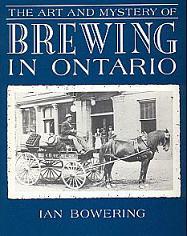 While I stand by my statement:
While I stand by my statement:
“…brewing history can be a tool or route to understanding for some but is ultimately unimportant if you do not need to tap into it…”
… I have to admit that I do like dabbling in it – as long as I stay within the reach of my own capabilities. I especially like dabbling in it care of a stack of bedside books when I am, like today, on the third day of the treatment for a blip of pneumonia. And good thing, too, as it’s not like the weeks of cough medications leading to this stage have left me longing for a tart gueuze. But, while we are at it, would it kill big pharmacy to make a expectorant that tastes like an imperial stout?
Anyway, one of the books recently added to the pile is 1988’s The Art And Mystery Of Brewing in Ontario by Ian Bowering. We suffer in Canada from a lack of understanding of ourselves and no where more than here in Ontario. Atlantic Canadians, Quebeckers and Western Canadians all are rightly proud of themselves even if it is largely based on how they have each been screwed in their own special way by that place to stand, place to grow, Ontar-i-ar-i-ar-i-o.
Bowering’s book helps with Ontario’s blandness. It sits in an important place with others on brewing in Canada and does one thing particularly well. It lists the breweries by town. Simple thing but it shows that brewing advanced across the province as the population advanced westerly from the early 1790s or before in eastern Kingston to the late 1890s in Rat Portage, over 2,000 km to the NW. It also shows that brewing was going on at a far larger scale, unexpected industrialization with far greater distribution earlier on than some might suggest. Brains Brewery in rural 1834 was producing 100 barrels a week. Lager was being made in Kitchener well before 1850 and even wee Huether Crystal Springs in little Neustadt delivered in a 70 km radius a few year later.
Information will advance and it is evident more information has come to light when we compare the listings for Kingston and compare them to the brand new book The Breweries of Kingston and The St. Lawrence Valley by Steve Gates which follows a similar structure. But as one wag recently stated:
…that there are others out there who will identify errata and offer corrections is something which will ultimately contribute to the further development and maturation of this particular field of study.
I might add that it is the only way it will further develop and mature. And not only through peer review and correction but building on the shoulders of others who have gone before. So Gates cites Bowering, Sneath cites Bowering, Mr. B cites Bowering, Pashley cites Mr. B and Sneath. It’s the way things work, the way we build the collective body of knowledge – if, that is, we are actually interested in presenting what actually was.
Why Did A Brewer In Kingston In 1815 Want Rye?
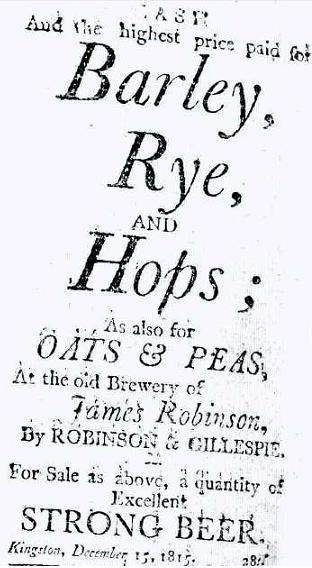 The ad is from page 4 of the Kingston Gazette, 6 January 1816. You can see at the bottom that it was placed on 15 December 1815. So many questions. What were Messrs Robinson and Gillespie up to? Why is rye placed between barley and hops in the large font while oats sit down there with the peas? Also, is “strong beer” something separate, something identifiable to the Kingstonian a year after the war with America? You will recall that a few months later in April, Albany strong beer is for sale. It also comes just a month after Richard Smith’s notice for plain “beer” – so was “strong beer” something they had the taste for still, almost 40 years after having to flee from their central NY homes at the beginning of the American Revolution? And why is it not “ale” when described in the Kingston papers?
The ad is from page 4 of the Kingston Gazette, 6 January 1816. You can see at the bottom that it was placed on 15 December 1815. So many questions. What were Messrs Robinson and Gillespie up to? Why is rye placed between barley and hops in the large font while oats sit down there with the peas? Also, is “strong beer” something separate, something identifiable to the Kingstonian a year after the war with America? You will recall that a few months later in April, Albany strong beer is for sale. It also comes just a month after Richard Smith’s notice for plain “beer” – so was “strong beer” something they had the taste for still, almost 40 years after having to flee from their central NY homes at the beginning of the American Revolution? And why is it not “ale” when described in the Kingston papers?
I just finished The Lion, the Eagle and Upper Canada by Jane Errington, a historian over at Royal Military College – they of the old school base ball. The book is well reviewed here but, short form, it’s an interesting view of early Upper Canada (1790s to 1820s) based in large part by review of early newspapers. In it, Errington suggests something of a window between the end of the War of 1812 in 1815 and, a few years later, a clampdown in trade and other contacts with the US towards the end of the decade. But even with her level of detail about the community, trade and industry, there is not much about beer itself. Meaning I am left unsure if beer was being traded within months of the end of a war, perhaps as a stop gap until local product restarted… if it was interrupted by the war… which is another question.
So, I was very happy to read in the comments that Steve Gates has published his history of brewing in the city and in the region. I couldn’t get out of the door to go get a copy but will tomorrow. Hopefully it will shed some light on what Robinson and Gillespie were up to.
In Kingston In November 1815 There Was Beer!
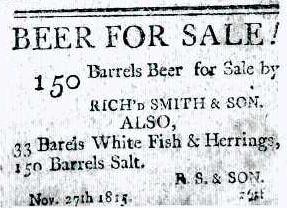
Beer for sale! Hallallujah!! BEER FOR SALE!!!
Remember what I suggested before? That where there is peace there is
beer? Well, on 27 November 1815, my town of Kingston was just nine months past the ratification of the Treaty of Ghent and five past the Battle of Waterloo. The proposed terms of Napoleon’s incarceration at St. Helena are announced in the same edition of the Kingston Gazette as was the reprimand of Major-General Proctor – the news oddly received care of an American paper… care of one from Montreal. Funny information and trade routes in those early post war days.
Where did the malt come from? Sure, Kingston was a key outpost bastion in the Empire, the guardian of the Great Lakes, St. Lawrence and Rideau but, still, who grew the grain that made the malt that made the beer? Was it a local 1815 crop or was it shipped from Britain or America? Where was it brewed? Notice that Richard Smith only calls it “beer” where a few months later he calls what he is selling Albany strong beer. Also, I don’t see another ad in the paper for beer. There are many fine things – fancy goods even. The front page of the 2 December 1815 issue includes notices offering Turkish opium, spices and sugars, China teas and and Port wine. The town had its need and apparently some issues for which it had supplies. But there was no other beer for sale.
It makes one consider that this may have been the first or at least an early shipment to make it to the town after the war. There very likely were beers in taverns but not necessarily. More drinks can be made from spirits and if you are transporting them up a river filled with rapids between here and Montreal, there is more bucks in batteaux that way. We learn from Roberts that punches and cocktails was the fashion, too. Taverns were posh. Not sure. But what ever it was about, beer was for sale. And it was worth letting people know.
Your 1816 Albany Ale Update From My Home Town
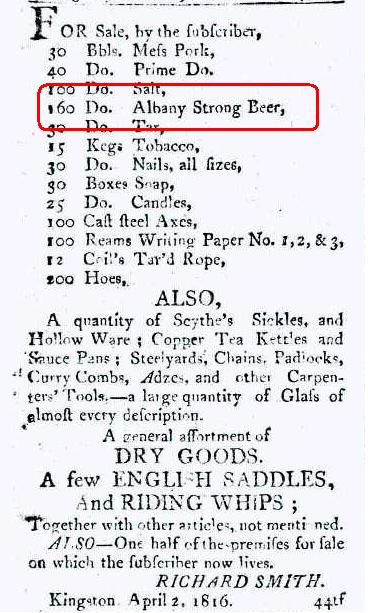 We have not found more Albany ale information for a while but this is your moment of zen. Just consider what it means. There is no Erie Canal. There are rapids on the St. Lawrence all the way to Montreal. There are about 4,000 people in this town. The War of 1812 ended one shipping season before… unless it was brought by sleigh. Oh, and “Do.” does not mean dozen. It means “ditto” so those are barrels. Amazing. From the Kingston Gazette on April 27th 1816.
We have not found more Albany ale information for a while but this is your moment of zen. Just consider what it means. There is no Erie Canal. There are rapids on the St. Lawrence all the way to Montreal. There are about 4,000 people in this town. The War of 1812 ended one shipping season before… unless it was brought by sleigh. Oh, and “Do.” does not mean dozen. It means “ditto” so those are barrels. Amazing. From the Kingston Gazette on April 27th 1816.
Oh – Heck – It’s Election Day In Ontario…
Ontario politics are sorta like that. People don’t notice that they are, with all the downloading of 30 years, the most important elections in the life of the nation. Because Ontario is that nice nerdy B+ kid who helps and never gets dates. Gives away the lunch money and gets threatened by smaller rude boys on the way home. Here’s is my guess at the outcome this election day.
Popular Vote:
40% – Grits
34% – Tory
18% – Dippers
2% – Greens
the rest% – the rest
Seats:
52 – Grits
38 – Tory
17 – Dippers
Not a brave guess or even one that makes sense. But I am sticking by it. Hope I remember to vote. Special good luck wishes to Vic Gupta with whom I worked in a bar in 1992 as well as the NDP here in town whose riding association is led by a fine vintage base ballista.
